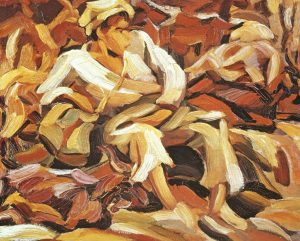The Visual Resources departments of Reed College, University of Virginia, and Virginia Tech have joined together to create online access to a unique collection of slides from the estate of distinguished Virginia Tech architecture professor Dr. Milka Tcherneva Bliznakov. The collection comprises a remarkable selection of 19th and 20th Century Bulgarian art as well as a sampling of Soviet avant-garde architecture.
A selection of 550 images is now available to the Reed community via the Art & Architecture database as part of Reed Digital Collections. Click HERE to access the images.

The art collection introduces the work of Bulgaria’s most prominent painters and sculptors, from the Surrealist experiments of Georges Papazoff to the relatively traditional landscapes of Nikola Tanev. This capsule history of Bulgarian art shows the progression towards the creation of a unique national style, a project of increasingly political importance as Bulgaria sought at various points throughout its history to establish its independence from mightier powers. The official political life of Bulgaria is represented by a series of monuments to various events throughout Bulgaria’s history, from the mythological past through the Tsarist period into the Soviet era, while the unofficial political atmosphere is documented in avant-garde prints and magazines and the political cartoons of Alexander Zhendov, which provide acerbic commentary on the state of early Soviet Bulgaria through the end of the second world war. This historical information is deftly conveyed by the careful selection of artists from different periods in Bulgaria’s turbulent history and the collection as a whole shows the role of art in the development of a Bulgarian national identity.
The architecture portion of the collection focuses on the activities of architects and sculptors affiliated with VKhUTEMAS, later VKhUTEIN, Moscow’s primary art school during the early Soviet period, 1921-1930, notable for its role in bringing Constructivism to prominence. The faculty of VKhUTEMAS—Tatlin, Rodchenko, El Lissitzky, Lyubov’ Popova, and others—are for the most part well known to a Western audience, but their students, many of whom went on to become prolific artists and architects in their own right, are largely unknown. This collection contains numerous examples of these students’ early work, demonstrating the remarkable range and flexibility of the VKhUTEMAS curriculum. These projects cover everything from abstract meditations on volume within space to highly detailed renderings of factories and residential complexes. Although many of these works remain firmly rooted in the realities of Russia at the time, some offer projections of a utopian Soviet future in which man will have overcome his base animal origins and cities will hover above the earth’s surface, moored to colossal airships.
Dr. Milka Tcherneva Bliznakov was a native of Varna, Bulgaria. Bliznakov received her master’s in architecture from the State Polytechnic of Sofia, Bulgaria, in 1951 and spent the next two decades practicing architecture in Bulgaria, France, and the United States, where she immigrated to in 1961. She received her Ph.D. in architecture from Columbia University in 1971 and started her academic career at University of Texas. In 1974 she moved to Virginia Tech and founded the International Archive of Women in Architecture, which documents the history of women’s contributions to the built environment. It continues to collect and archive the professional papers of women architects, landscape architects, designers, architectural historians and critics, and urban planners, as well as the records of women’s architectural organizations. Bliznakov received many honors and awards throughout her academic career, including two Fulbright Hays Fellowships, two International Research and Exchange Grants, and a National Endowment for the Arts Grant.
—
Online access to Dr. Milka Tcherneva Bliznakov’s collection would not have been possible without the hard work and support of Rose Lewis [‘13] and Dr. Lena M. Lencek.
For more information contact Brooke Sansosti in the Visual Resources Collection bsansost@reed.edu

